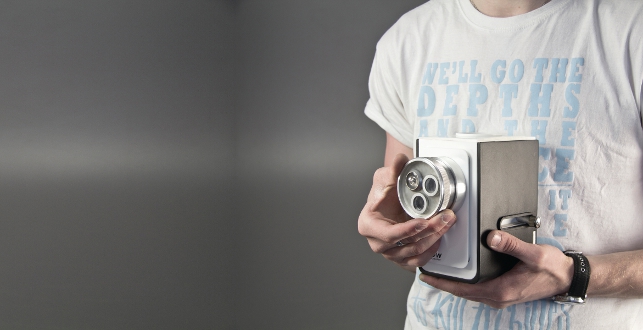David McCourt
Duncan of Jordanstone College of Art & Design, University of Dundee
Stepping back from the point-and-click haste that cameraphone convenience has delivered, the Slow Photography Camera offers an alternate route that plays on traditional photographic principles without losing the digital convenience.

The purpose of the Slow Photography camera is to provide a natural steppingstone between using a mobile phone as a camera before taking the plunge into professional grade digital photography
Duncan of Jordanstone College of Art & Design student, David McCourt, has designed a casing for the Apple iPhone 4, one of the top three most used cameras. The idea is to provide a natural stepping-stone between using a cameraphone and professional-grade digital SLR camera.
The Slow Photography Camera has three lenses; fixed focal length, macro and fisheye, all built into a manually operated turret. The user must then carefully compose their shot by looking through the top-down viewfinder and push the shutter release.
“I introduced the concept along with sketch models to some of my contacts, who are fantastic photographers, to gauge their response not only to see if it was a viable product, but to realise where the glitches and issues lay,” says McCourt
“Creating an original design for something that as of two months ago did not exist was quite daunting: how was the camera meant to look? When I first entered the workshop to create the camera, I was heavily influenced by cameras built in the USSR. I have always been fascinated by their tank-like build. I wanted to replicate this effect in my camera as best I could.”
Sketches were built into 3D models with accurate dimensions in SolidWorks before the prototype camera casing was built by hand in the university workshops.
The project is currently in negotiation to be created in a limited number, giving McCourt an exciting platform for his product design skills, and another camera for photographers to lust after.
Molly Anderson
Design Products MA, Royal College of Art
When striving for aesthetic beauty, designers can sometimes lose what is key to the product’s functionality, however in this instance the design finds its appeal in the simplicity of its shape.
Leading on from a larger project about collections, Molly Anderson was inspired to create a cutlery set by tools and in particular a radiator key found in a local hardware shop.
“The hexagonal shape of the handle is something that we are all very familiar with, particularly for handheld products like Allen keys and pencils, providing both grip and comfort,” explains Anderson.
“Development from concept to prototype started from the radiator key as the initial ‘sketch’. It included several rounds of quick model making to get a feeling for form and proportion, combined with sketching to define the details.”
“When I was happy with each of the designs, they were built in 3D CAD software providing greater accuracy and refinement of both the form and surfaces.”
After much sketching the knives, forks and spoons were built in Rhino for the quick iteration of surfaces, before 3D printing was used to make physical models once the objects had been translated into 3D software.
“I think it is great for quick prototyping, the speed and accuracy allows you to verify the real object, as you’re designing it; how it looks and feels, which is very important,” explains Anderson.
For the MA graduate the biggest challenge was getting the feel for the object while using virtual models: “replicating the simplicity and natural form that you create from making objects by hand into the virtual 3D world.”
Anderson’s graduation show (which is taking place from 24th June to 3rd July 2011) will feature several other groups of products. “Of course, the show is only a moment in the process, so there will certainly be more development if I wanted to take anything to market,” she says.
Richard Drummond
MDes Boat Design, University of Coventry
Following a five-month graduate placement at Studio Starkel, in Trieste, Italy, Richard Drummond’s final year project is aimed at sustainability in the yacht industry and particularily how it can be realistically implemented into projects in the near future.

The yacht Aeolus
“With the yacht industry showing signs of recovery, any new design must be tailored to the new economic climate,” says Drummond. “New clients may have never owned a large yacht before, they will be less likely to make large risky investments on unproven technologies and will want more for their money on a tighter budget.”
“Yachts of the future have to take into account the ‘green’ trend that is emerging throughout industrial design and the wider world. They have to be more representative of the owners and their business ideologies. Additionally, they must be at the forefront of future luxury, yet still hold true to the classic ideology of the Superyacht.”
His answer to these design challenges is the Aeolus, a 68m sloop rigged sailing yacht. With particular attention paid to its performance rig, it means that the yacht can be sailed in almost any condition at speed. Meanwhile, 10 tonnes of Lithium Ion batteries allow it to slip silently in and out of port by electric motor.
Exterior styling is based on the proportions of classic hull lines combined with a contemporary glass house superstructure that allows natural light into the upper deck interior and the double height dining room. The interior continues the theme of modern interpretations of classic yacht design, with furniture manufactured out of sustainably luxurious materials.
The project was designed primarily in Alias, with some of the surfacing done in Rhino, with the final rendering giving an impressive view of what the Aeolus would look like at sea. 
Final year degree students show their best







